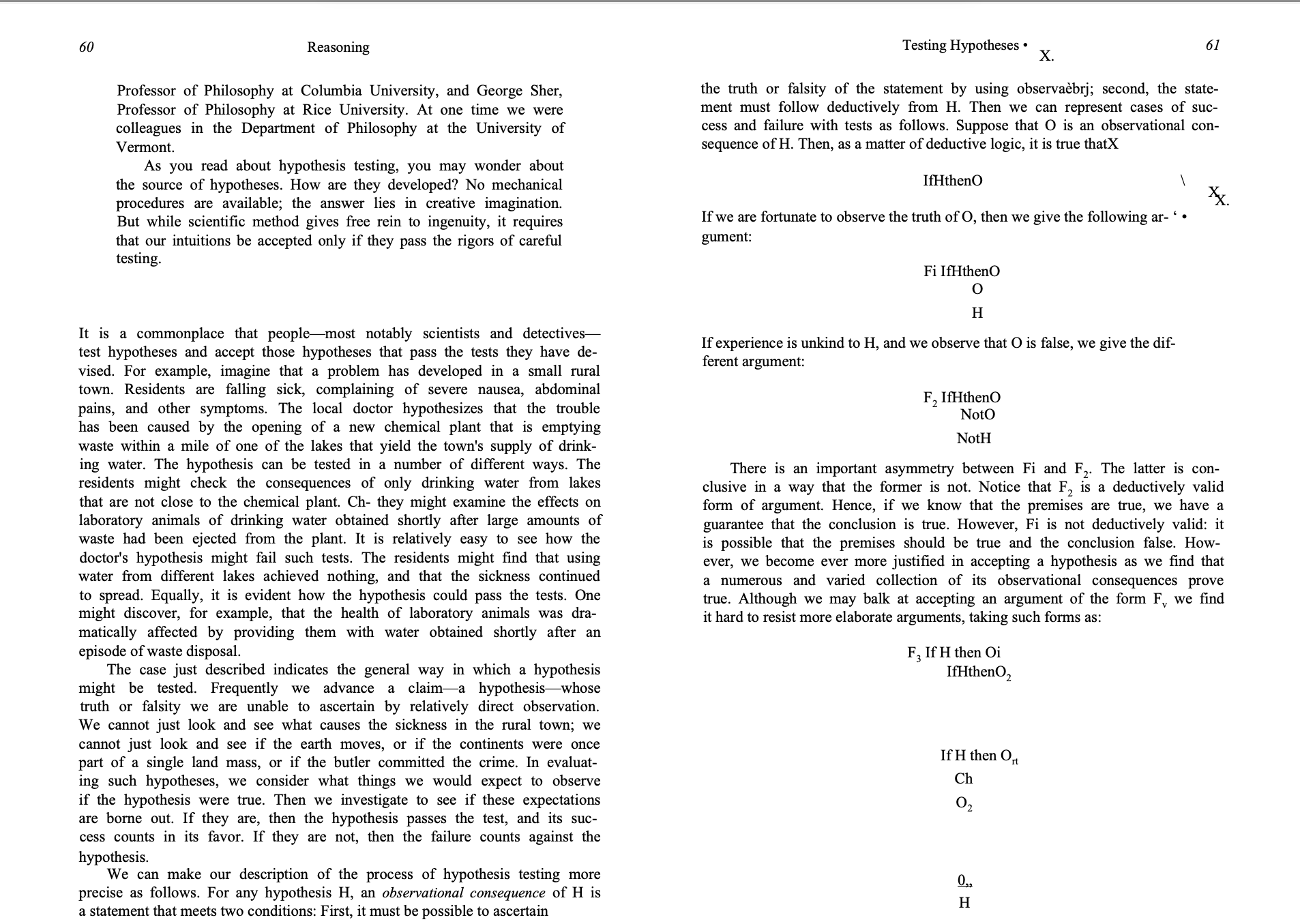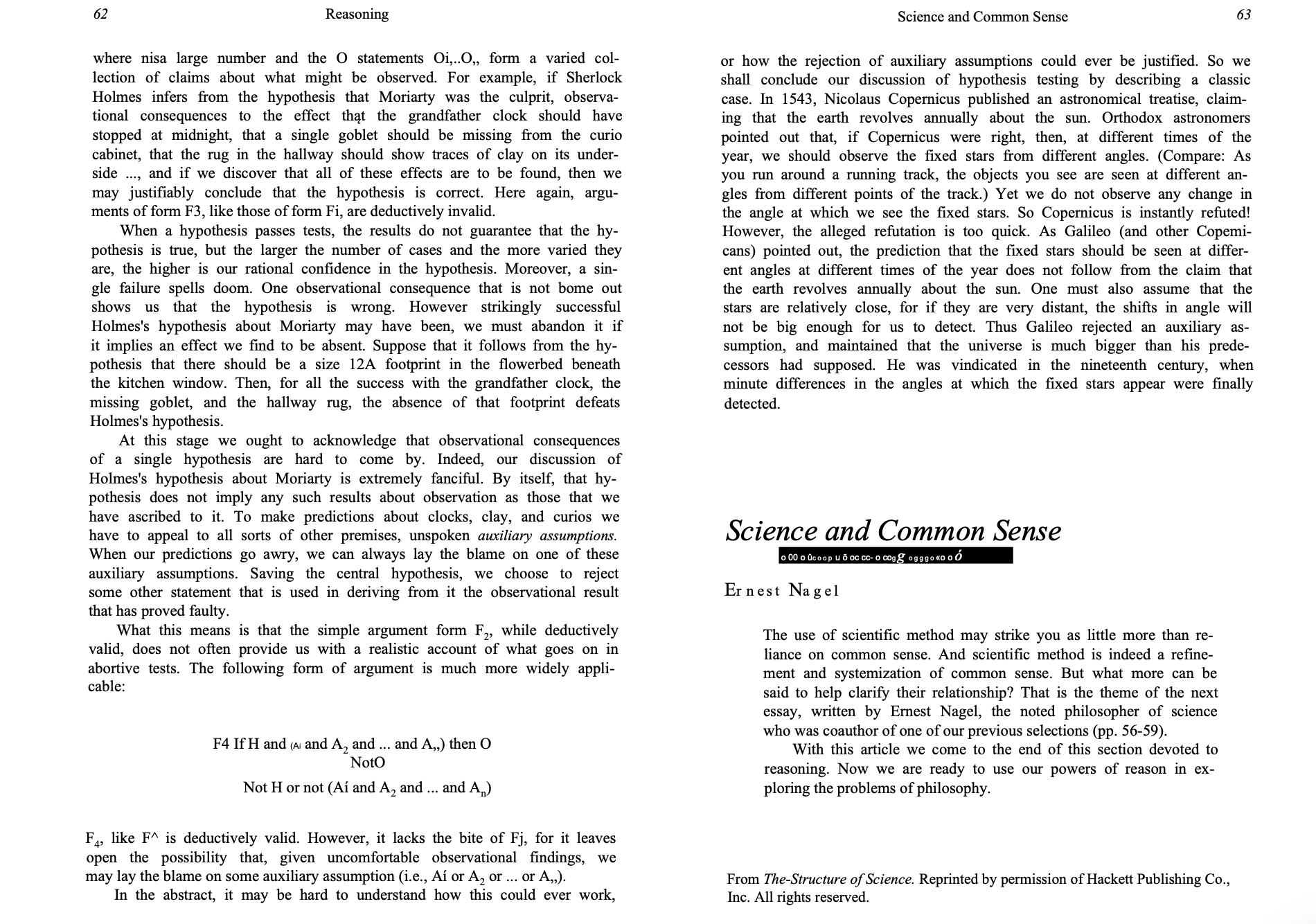

60 Reasoning Professor of Philosophy at Columbia University, and George Sher, Professor of Philosophy at Rice University. At one time we were colleagies in the Department of Philosophy at the University of Vermont As you read about hypothesis testing, you may wonder about the source of hypotheses. How are they developed? No mechanical procedures are available; the answer lies in creative imagination. But while scientic method gives free rein to ingenuity, it requires that our intuitions be accepted only if they pass the rigors of careful testing It is a commonplace that peoplkmost notably scientists and detectivesi test hypotheses and accept those hypotheses that pass the tests they have de- vised. For example, imagine that a problem has developed in a small rural town. Residents are falling sick, complaining of severe nausea, abdominal pains, and other symptoms. The local doctor hypothesizes that the trouble has been caused by the opening of a new chemical plant that is emptying waste within a mile of one of the lakes that yield the town's supply of drink- ing water. The hypothesis can be tested in a number of different ways. The residents might check the consequences of only drinking water from lakes that are not close to the chemical plant Ch- they might examine the effects on laboratory animals of drinking water obtained shortly aer large amounts of waste had been ejected from the plant. It is relatively easy to see how the doctor's hypothesis might fail such tests. The residents might nd that using water from different lakes achieved nothing, and that the sickness continued to spread. Equally, it is evident how the hypothesis could pass the tests. One might discover, for example, that the health of laboratory animals was dra- matically affected by providing them with water obtained shortly after an episode of waste disposal. The case just described indicates the general way in which a hypothesis might be tested. Frequently we advance a claima hypothesiswhose truth or falsity we are unable to ascertain by relatively direct observation. We cannot just look and see what causes the sicloiess in the rural town; we cannot just look and see if the earth moves, or if the continents were once part of a single land mass, or if the butler committed the crime. In evaluat- ing such hypotheses, we consider what things we would expect to observe if the hypothesis were true. Then we investigate to see if these expectations are borne out. If they are, then the hypothesis passes the test, and its suc- cess counts in its favor. If they are not, then the failure counts against the hypothesis. We can make our description of the process of hypothesis testing more precise as follows. For any hypothesis H, an observational consequence of H is a statement that meets two conditions: First, it must be possible to ascertain Testing Hypotheses - X 61 the truth or falsity of the statement by using observaebrj; second, the state- ment must follow deductively from H. Then we can represent cases of suc- cess and failure with tests as follows. Suppose that O is an observational con- sequence of H. Then, as a matter of deductive logic, it is true thatX I-IthenO \\ )54. If we are fortunate to observe the truth of 0, then we give the following ar- ' - gument: Fi IthhenO 0 H If experience is unkind to H, and we observe that 0 is false, we give the dif- ferent argument: F 2 I-IthenO NotO NotH There is an important asymmetry between Fi and F2. The latter is con- clusive in a way that the former is not. Notice that F2 is a deductively valid form of argument. Hence, if we know that the premises are true, we have a guarantee that the conclusion is true. However, Fi is not deductively valid: it is possible that the premises should be true and the conclusion false. HoW ever, we become ever more justied in accepting a hypothesis as we nd that a numerous and varied collection of its observational consequences prove true. Although we may balk at accepting an argument of the form F', we nd it hard to resist more elaborate augments, taking such forms as: F, If H then 0i IithenOz IfH then ort Ch 02 :I? 62 Reasoning where nisa large number and the 0 statements 0L..0,, form a varied col lection of claims about what might be observed. For example, if Sherlock Holmes infers from the hypothesis that Moriarty was the culprit, observa- tional consequences to the effect that the grandfather clock should have stopped at midnight, that a single goblet should be missing from the curio cabinet, that the rug in the hallway should show traces of clay on its under- side ..., and if we discover that all of these effects are to be found, then we may justifiably conclude that the hypothesis is correct. Here again, argui- ments of form F3, like those of form Fi, are deductively invalid. When a hypothesis passes tests, the results do not guarantee that the hy- pothesis is true, but the larger the number of cases and the more varied they are, the higher is our rational condence in the hypothesis. Moreover, a sin- gle failure spells doom. One observational consequence that is not home out shows us that the hypothesis is wrong. However strikingly successful Holmes's hypothesis about Moriarty may have been, we must abandon it if it implies an effect we nd to be absent. Suppose that it follows from the hy pothesis that there should be a size 12A footprint in the owerbed beneath the kitchen window. Then, for all the success with the grandfather clock, the missing goblet, and the hallway rug, the absence of that footprint defeats Holmes's hypothesis. At this stage we ought to acknowledge that observational consequences of a single hypothesis are hard to come by. Indeed, our discussion of Hohnes's hypothesis about Moriarty is extremely fanciful. By itself, that hy- pothesis does not imply any such results about observation as those that we have ascribed to it. To make predictions about clocks, clay, and curios we have to appeal to all sorts of other premises, unspoken auxiliary assumptions. When our predictions go awry, we can always lay the blame on one of these auxiliary assumptions. Saving the central hypothesis, we choose to reject some other statement that is used in deriving from it the observational result that has proved faulty. What this means is that the simple augment form F2, while deductively valid, does not often provide us with a realistic account of what goes on in abortive tests. The following form of argument is much more widely appli- cable: F4 IfH and (m and A2 and and A,,) thenO NotO Not H or not (Ai and A2 and andAn) F,, like F" is deductively valid. However, it lacks the bite of Fj, for it leaves open the possibility that, given uncomfortable observational ndings, we may lay the blame on some auxiliary assumption (i.e., Ai or A2 or or A,,). In the abstract, it may be hard to understand how this could ever work, Science and Common Sense 63 or how the rejection of auxiliary assumptions could ever be justified. So we shall conclude our discussion of hypothesis testing by describing a classic case. In 1543, Nicolaus Copernicus published an astronomical treatise, claim- ing that the earth revolves annually about the sun. Orthodox astronomers pointed out that, if Copernicus were right, then, at different times of the year, we should observe the xed stars from different angles. (Compare: As you run around a running track, the objects you see are seen at different an- gles from different points of the track.) Yet we do not observe any change in the angle at which we see the xed stars. So Copernicus is instantly refuted! However, the alleged refutation is too quick. As Galileo (and other Copemi cans) pointed out, the prediction that the xed stars should be seen at differ- ent angles at different times of the year does not follow from the claim that the earth revolves annually about the sun. One must also assume that the stars are relatively close, for if they are very distant, the shis in angle will not be big enough for us to detect. Thus Galileo rejected an auxiliary as sumption, and maintained that the universe is much bigger than his prede cessors had supposed He was vindicated in the nineteenth century, when minute differences in the angles at which the xed stars appear were nally detected. Science and Common Sense 'i'JDLIuUaECC' V100 Ernest Nagel The use of scientic method may strike you as little more than re- liance on common sense. And scientic method is indeed a rene- ment and systemization of common sense. But what more can be said to help clarify their relationship? That is the theme of the next essay, written by Ernest Nagel, the noted philosopher of science who was coauthor of one of our previous selections (pp. 56-59). With this article we come to the end of this section devoted to reasoning. Now we are ready to use our powers of reason in ex ploring the problems of philosophy. From The-Structure of Science. Reprinted by permission of Hackett Publishing (30., Inc. All rights reserved










